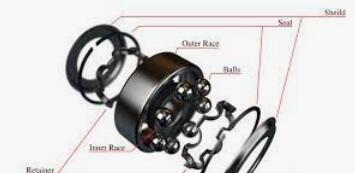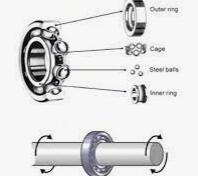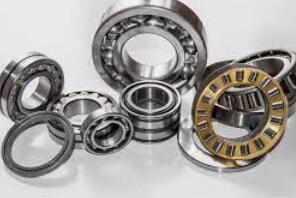Can Ball Bearings Reduce Friction?
Looking for a fun and informative read?
Look no further! This article explores the fascinating world of ball bearings and how they can help reduce friction in various applications.
So why wait? Dive into this exciting topic today!
Are you tired of dealing with friction in your machines and devices?
Well, have no fear because ball bearings are here!
These tiny wonders can help reduce friction and improve the efficiency of various applications.
But how do they work, and what makes them so special?
We'll explore the fascinating world of ball bearings, their different types and uses, and how they can benefit you in everyday life.
So, sit back, relax, and let's dive into the exciting science behind ball bearings!
Can ball bearings reduce friction?
-1.Round shape allows for smooth rolling motion, reducing friction between moving parts.
-2.Hardness and durability help withstand high pressure and wear, resulting in less friction over time.
-3.Low coefficient of friction reduces the amount of force required to move the bearing.
-4.Lubrication can further reduce friction by providing a layer of protection between the bearing and its surrounding components.
-5.Different types of ball bearings, such as angular contact or thrust bearings, are designed for specific applications to maximize efficiency and decrease friction.
In this article, we'll go deeper into the science behind these tiny marvels and explore their different types and uses.
You'll learn about the materials used to make them, the factors that affect their performance, and the benefits they offer over other types of bearings.
So, keep reading to discover the fascinating world of ball bearings and how they can make your life easier and more efficient!
How Ball Bearings Work?

Structure and Function of Ball Bearings
Ball bearings are mechanical components designed to reduce friction between moving parts.
They consist of a simple but effective structure: two rings, known as the outer and inner raceways, with a set of small balls placed in between.
The balls are free to rotate within the raceways, allowing for smooth rolling motion while minimizing friction.
The shape of ball bearings is critical to their function.
The balls are typically round or cylindrical, which helps them move smoothly within the raceways and minimize contact with other components.
They are also made from materials that are hard and durable, such as steel or ceramic, to withstand high pressure and wear.
In addition to their shape and construction materials, lubrication plays an important role in the performance of ball bearings.
Lubricant provides a protective layer between the bearing and its surrounding components, reducing friction and preventing wear over time.
Ball bearings come in various types and sizes, each designed for specific applications.
For example, angular contact bearings are ideal for supporting axial loads, while radial bearings are better suited for supporting radial loads.
Thrust bearings, on the other hand, are designed to withstand both axial and radial loads.
Ball bearings are an essential component in many mechanical devices, helping to increase efficiency and reduce wear and tear on components.
Their simple yet effective design and durability make them a popular choice for a wide range of applications, from industrial machinery to household appliances.
How Ball Bearings Reduce Friction?

Ball bearings help to reduce friction by enabling smooth rolling motion between two surfaces.
They do this using a simple but effective mechanism: the balls placed between the two raceways of the bearing roll freely, allowing for minimal contact and friction between the surfaces.
When an external force is applied to one of the raceways, the balls rotate in response, distributing the load evenly across the surface.
This reduces the amount of force required to move the bearing and minimizes the amount of wear and tear on the components, thereby reducing friction.
In addition to their round shape, ball bearings are also made from materials that are hard and durable, such as steel or ceramic.
This allows them to withstand high pressure and wear over time, while still maintaining their shape to minimize friction.
Finally, lubrication can further reduce friction by providing a layer of protection between the bearing and its surrounding components.
Lubricant helps to prevent direct contact between metal surfaces, which can cause friction, heat, and wear.
Ball bearings provide a cost-effective and efficient solution for reducing friction in a wide range of mechanical applications.
Their simple design, durability, and ability to operate smoothly even under heavy loads make them an essential component in many machines and devices today.
Factors That Affect Friction
Several factors can affect friction between two surfaces, including surface material, contact area, lubrication, and load.
Surface Material
The type of material in contact with each other significantly affects friction.
Surfaces with high roughness or irregularities tend to have higher friction as the peaks and valleys create more contact points that slow down movement.
However, certain materials also have lower coefficients of friction than others.
For example, metal on metal may have a higher coefficient of friction than plastic on metal.
Contact Area
Friction increases with an increase in the contact area between two surfaces.
When two surfaces have a larger contact area, there are more points of contact between them,
which results in greater resistance to motion and thus higher friction.
Lubrication
The presence of a lubricant, such as oil or grease, can help reduce friction between two surfaces.
Lubricants create a film between the surfaces that reduces direct contact, lowering friction and preventing wear and tear.
Load
Friction also increases with an increase in the load placed on a surface.
As the amount of pressure on the surfaces increases, the resistance to motion also increases, resulting in higher friction.
Conversely, reducing the load on a surface can decrease friction.
Several factors can affect friction, and understanding these factors is essential in designing machinery or components that operate smoothly and efficiently.
By selecting the right materials, optimizing contact area, using appropriate lubrication, and managing loads,
engineers can effectively minimize friction and improve the performance and longevity of their systems.
Advantages of Using Ball Bearings

Ball bearings offer several advantages over other types of bearings, including reduced friction, increased efficiency, and extended lifespan.
Reduced Friction
The rolling motion of ball bearings allows for minimal contact between the bearing and its surrounding components, resulting in reduced friction.
This is particularly important in high-speed applications or where there is a lot of repetitive motion,
as it reduces energy consumption and minimizes wear and tear on the components.
Increased Efficiency
By reducing friction and minimizing energy loss, ball bearings can significantly increase the efficiency of mechanical systems.
They allow for smoother operation, require less force to move and help reduce the amount of heat generated during operation.
Extended Lifespan
Ball bearings are designed to withstand high pressure and wear, making them a durable and long-lasting component in many applications.
Properly lubricated and maintained ball bearings can provide smooth and efficient operation for years, reducing the need for frequent replacements and repairs.
The advantages of using ball bearings make them an essential component in a wide range of applications.
They help reduce friction, increase efficiency, and extend the lifespan of machinery and equipment, ultimately providing cost savings and improved performance.
Limitations of Using Ball Bearings
While ball bearings offer numerous advantages, they also have some limitations that designers and engineers need to consider when selecting the appropriate bearing for a specific application.
These limitations include the potential for wear and tear, sensitivity to misalignment, and higher cost compared to some alternatives.
Potential for Wear and Tear
Despite their durability, ball bearings can still experience wear and tear over time, particularly in applications with high loads or heavy use.
This can result in reduced performance, increased noise, and even failure if left unchecked.
Regular maintenance, such as lubrication and replacement of worn components, is essential for ensuring the longevity of ball bearings.
Sensitivity to Misalignment
Ball bearings are sensitive to misalignment and may fail prematurely if they are not installed correctly or do not operate within certain tolerances.
Misalignment can cause additional stress on the bearing, leading to deformation, uneven wear, and ultimately, failure.
Proper installation and alignment are crucial for the optimal performance and lifespan of ball bearings.
Higher Cost Compared to Some Alternatives
While ball bearings offer numerous advantages over other types of bearings, they also tend to be more expensive.
This is due to the higher material costs and manufacturing processes involved in producing ball bearings.
In some cases, alternative bearing solutions may be more cost-effective, depending on the specific requirements of the application.
While ball bearings provide excellent performance and benefits, they also have some limitations that designers and engineers need to be aware of.
By properly selecting, installing, and maintaining ball bearings, these limitations can be mitigated, ensuring optimal performance and longevity of the bearing and the overall system.
Conclusion
In conclusion, ball bearings are an essential component in many mechanical devices, providing a cost-effective and efficient solution for reducing friction.
Their round shape, hard and durable materials, and lubrication all work together to enable smooth rolling motion while minimizing wear and tear on components.
By selecting the right type of ball bearing for your specific application and ensuring proper installation and maintenance, you can reduce friction, increase efficiency, and extend the lifespan of your mechanical systems.





